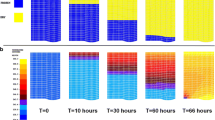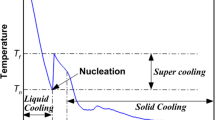Abstract
Freeze-drying is a deceptively complex operation requiring sophisticated design of a robust and efficient process that includes understanding and planning for heterogeneity across the batch and shifts in parameters due to vial or lyophilizer changes. A software tool has been designed to assist in process development and scale-up based on a model that includes consideration of the process heterogeneity. Two drug formulations were used to test the ability of the new tool to develop a freeze-drying cycle and correctly predict product temperatures and drying times. Model inputs were determined experimentally, and the primary drying heterogeneous freeze-drying model was used to design drying cycles that provided data to verify the accuracy of model-predicted product temperature and primary drying time. When model inputs were accurate, model-predicted primary drying times were within 0.1 to 15.9% of experimentally measured values, and product temperature accuracy was between 0.2 and 1.2°C for three vial locations, center, inner edge, and outer edge. However, for some drying cycles, differences in vial heat transfer coefficients due to changes in shelf and product temperature as well as altered product resistance due to product temperature-dependent microcollapse increased inaccuracy (up to 28.6% difference in primary drying time and 5.1°C difference in product temperature). This highlights the need for careful determination of experimental conditions used to calculate model inputs. In future efforts, full characterization of location- and shelf temperature-dependentKv as well as location- and product temperature-dependentRp will enhance the accuracy of the predictions by the model within the user-friendly software.








Similar content being viewed by others
References
SEQENS. What is driving the growing demand for lyophilization? Available from: https://cdmo.seqens.com/api-manufacturing/what-is-driving-the-growing-demand-for-lyophilization/, [Accessed 24th April 2020].
Chang BS, Reilly M, Chang H. Lyophilized biologics. In: Varshney D, Singh M, editors. Lyophilized biologics and vaccines: modality-based approaches. New York: Springer; 2015.
Pikal MJ. Freeze drying. In: Encyclopedia of pharmaceutical technology, vol. 1299. N Y: Marcel Dekker; 2002. p. 1326.
Mirasol F. Lyophilization presents complex challenges. BioPharm Int. 2020;33(1).
Chang BS, Fischer N. Development of an efficient single-step freeze-drying cycle for protein formulations. Pharm Res. 1995;12(6):831–7.
Mockus LN, Paul TW, Pease NA, Harper NJ, Basu PK, Oslos EA, Sacha GA, Kuu WY, Hardwick LM, Karty JJ, Pikal MJ, Hee E, Khan MA, Nail SL. Quality by design in formulation and process development for a freeze-dried, small molecule parenteral product: a case study. Pharm Dev Technol. 2011;16(6):549–76.
Patel SM, Pikal MJ. Lyophilization process design space. J Pharm Sci. 2013;102(11):3883–7.
Roy ML, Pikal MJ. Process control in freeze drying: determination of the end point of sublimation drying by an electronic moisture sensor. J Parenter Sci Technol. 1989;43:60–6.
Tang X, Pikal MJ. Design of freeze-drying processes for pharmaceuticals: practical advice. Pharm Res. 2004;21(2):191–200.
Schneid SC, Gieseler H, Kessler WJ, Luthra SA, Pikal MJ. Optimization of the secondary drying step in freeze drying using TDLAS technology. PharmSciTech. 2011;12(1):379–87.
Rambhatla S, Tchessalov S, Pikal MJ. Heat and mass transfer scale-up issues during freeze-drying, III: control and characterization of dryer differences via operational qualification tests. PharmSciTech. 2006;7(2):E61–70.
MacKenzie A. Collpase during freeze drying – qualitative and quantitative aspects. In: Goldblith S, Rey L, Rothmayr W, editors. Freeze drying and advanced food technology. London: Academic Press; 1975.
Pikal MJ, Shah S. The collapse temperature in freeze-drying - dependence on measurement methodology and rate of water removal from the glassy phase. Int J Pharm. 1990;62(2–3):165–86.
Greco K, Mujat M, Galbally-Kinney KL, Hammer DX, Ferguson RD, Iftimia N, Mulhall P, Sharma P, Kessler WJ, Pika MJ. Accurate prediction of collapse temperature using optical coherence tomography-based freeze-drying microscopy. J Pharm Sci. 2013;102(6):1773–85.
Depaz RA, Pansare S, Patel SM. Freeze-drying above the glass transition temperature in amorphous protein formulations while maintaining product quality and improving process efficiency. J Pharm Sci. 2016;105(1):40–9.
Johnson R, Lewis L. Freeze-drying protein formulations above their collapse temperatures: possible issues and concerns. Am Pharm Rev. 2011; Available from https://www.americanpharmaceuticalreview.com/Featured-Articles/37021-Freeze-Drying-Protein-Formulations-above-their-Collapse-Temperatures-Possible-Issues-and-Concerns/ [Accessed 29th November 2020].
Pikal MJ. Freeze-drying of proteins. Part I: Process Design. Biochem Pharmacol. 1990;3:18–28.
Pikal MJ. Use of laboratory data in freeze drying process design: heat and mass transfer coefficients and the computer simulation of freeze drying. J Parenter Sci Technol. 1985;39:115–38.
Scutella B, Bourles E. Development of a freeze-drying cycle via design space approach: a case study on vaccines. Pharm Dev Technol. 2020;25(10):1302–13.
Pisano R, Fissore D, Barresi AA. Freeze-drying cycle optimization using model predictive control techniques. Ind Eng Chem Res. 2011;50(12):7363–79.
Shivkumar G, Kazarin PS, Strongrich AD, Alexeenko AA. LyoPRONTO: an open-source lyophilization process optimization tool. PharmSciTech. 2019;20:238.
Wegiel L. Primary drying optimization using a three-dimensional design space. Presented at CPPR Conference Freeze Drying of Pharmaceuticals and Biologicals Conference. Germany: Garmisch-Partenkirchen; 2014. p. 23–6.
Nail SL, Searles JM. Elements of quality by design in development and scale-up of freeze-dried parenterals. BioPharm Int. 2008;21(1):44–52.
Patel AM, Chaudhuri S, Pikal MJ. Choked flow and importance of Mach I in freeze-drying process design. Chem Eng Sci. 2010;65(21):5716–27.
Pikal MJ, Pande P, Bogner R, Sane P, Mudhivarthi V, Sharma P. Impact of natural variations in freeze-drying parameters on product temperature history: application of quasi steady-state heat and mass transfer and simple statistics. PharmSciTech. 2018;19(7):2828–42.
Pikal MJ, Bogner R, Mudhivarthi V, Sharma P, Sane P. Freeze-drying process development and scale-up: scale-up of edge vial versus center vial heat transfer coefficients, Kv. J Pharm Sci. 2016;105(11):3333–43.
Gieseler H, Kessler WJ, Finson MF, Davis SJ, Mulhall PA, Bons V, Debo DJ, Pikal MJ. Evaluation of tunable diode laser absorption spectroscopy for in-process water vapor mass flux measurements during freeze-drying. J Pharm Sci. 2007;96(7):1776–93.
Schneid S, Gieseler H, Kessler W, Pikal MJ. Position dependent vial heat transfer coefficient: a comparison of tunable diode laser absorption spectroscopy and gravimetric measurements. Presented at CPPR Freeze-Drying of Pharmaceuticals and Biologicals. Germany: Garmisch-Partenkirchen; 2006. p. 3–6.
Kuu WY, Nail SL, Sacha G. Rapid determination of vial heat transfer parameters using tunable diode laser absorption spectroscopy (TDLAS) in response to step-changes in pressure set-point during freeze-drying. J Pharm Sci. 2009;98(3):1136–54.
Schneid SC, Gieseler H, Kessler WJ, Pikal MJ. Non-invasive product temperature determination during primary drying using tunable diode laser absorption spectroscopy. J Pharm Sci. 2009;98(9):3401–18.
Kuu WY, O’Bryan KR, Hardwick L, Paul TW. Product mass transfer resistance directly determined during freeze-drying cycle runs using tunable diode laser absorption spectroscopy (TDLAS) and pore diffusion model. Pharm Dev Technol. 2011;16(4):343–57.
Bogner R. Factors that influence product resistance and methods to measure product resistance. SP Scientific Webinar, 2020 March 23rd. Available from: https://www.spscientific.com/Webinars/Archives / [Accessed 10th October 2020].
Sharma P, Kessler WJ, Bogner R, Thakur M, Pikal MJ. Applications of the tunable diode laser absorption spectroscopy: in-process estimation of primary drying heterogeneity and product temperature during lyophilization. J Pharm Sci. 2019;108(1):416–30.
Tang X, Nail SL, Pikal MJ. Freeze-drying process design by manometric temperature measurements: design of a smart freeze-dryer. Pharm Res. 2005;22(4):685–700.
Pikal MJ, Roy ML, Shah S. Mass and heat transfer in vial freeze-drying of pharmaceuticals: role of the vial. J Pharm Sci. 1984;73(9):1224–37.
Engineering ToolBox, (2004). Ice - thermal properties. [online] Available at: https://www.engineeringtoolbox.com/ice-thermal-properties-d_576.html [Accessed 27 July 2021].
Jancso G, Pupezin J, Van Hook WA. Vapor pressure of ice between+ 10-2 and-1020. J Phys Chem. 1970;74(15):2984–9.
Patel SM, Nail SL, Pikal MJ, Geidobler R, Winter G, Hawe A, Davagnino J, Gupta SR. Lyophilized drug product cake appearance: what is acceptable? JPharmSci. 2017;106:1706–21.
Funding
This work was performed under a Project Award Agreement from the National Institute for Innovation in Manufacturing Biopharmaceuticals (NIIMBL) and financial assistance award 70NANB17H002 from the US Department of Commerce, National Institute of Standards and Technology. Drug substance was provided at no cost by Genentech and Merck.
Author information
Authors and Affiliations
Contributions
All authors contributed to the study conception and design. Material preparation, data collection, and analysis were performed by Robin Bogner, Emily Gong, William Kessler, and Arushi Manchanda. Michael Hinds developed the software. Jessie Zhao, Puneet Sharma, Akhilesh Bhambhani, and Justin Stanbro provided drug substance. The first draft of the manuscript was written by Robin Bogner, Emily Gong, and William Kessler, and all authors commented on previous versions of the manuscript. All authors read and approved the final manuscript.
Corresponding author
Ethics declarations
Conflict of Interest
The authors declare no competing interests
Additional information
Guest Editors: Alexander Russell and Maxx Capece
Publisher’s Note
Springer Nature remains neutral with regard to jurisdictional claims in published maps and institutional affiliations.
Supplementary Information
Supplemental Figure 1
Lyophilization primary drying process modeling software Graphical User Interface used to fit product resistance data and determine product resistance parameters R0, A1 and A2. (PNG 7365 kb)
Supplemental Figure 2
Product resistance to drying, Rp, at Ldry = 2/3 Lmax as a function of the average product temperature during primary drying for Formulation B. (PNG 4040 kb)
Rights and permissions
About this article
Cite this article
Bogner, R., Gong, E., Kessler, W. et al. A Software Tool for Lyophilization Primary Drying Process Development and Scale-up Including Process Heterogeneity, I: Laboratory-Scale Model Testing. AAPS PharmSciTech 22, 274 (2021). https://doi.org/10.1208/s12249-021-02134-3
Received:
Accepted:
Published:
DOI: https://doi.org/10.1208/s12249-021-02134-3




